The World’s a Twisted Place. Thank God We’ll Always Have Mister Softee
Sixty-five years ago, two sons of immigrants burst from a West Philly garage and revolutionized the ice-cream business. The city has changed. Mister Softee hasn’t — and that’s a good thing.
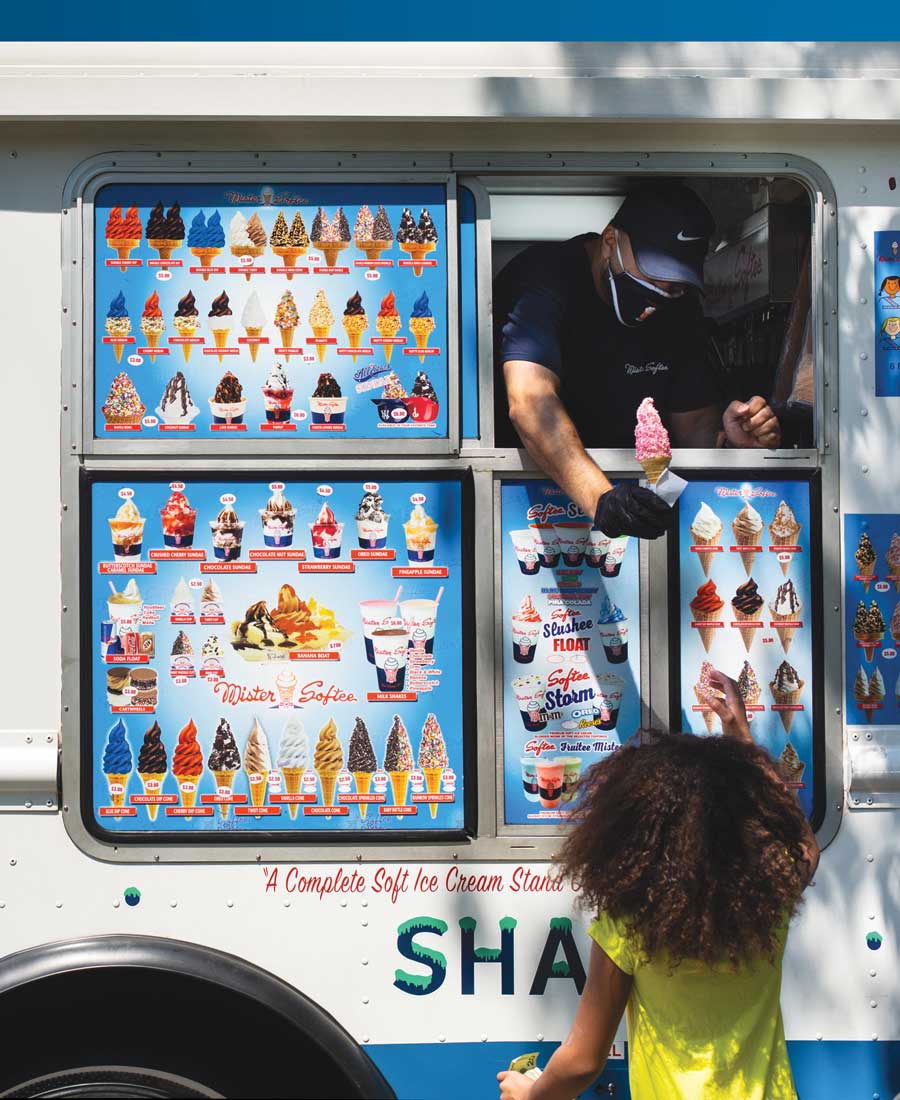
Mister Softee franchisee Morad Khalil serves a strawberry-shortcake-topped vanilla cone. Photograph by Scott Lewis
It’s an early spring afternoon in West Oak Lane, and I’m about to get ice-cream-man lessons from Morad Khalil, a Mister Softee franchisee who’s been pulling cones of soft-serve on the streets of Philadelphia since the 1990s. It’s only March — the official ice-cream season doesn’t start until April — but unlike Rita’s Italian Ice or the Phillies, there’s no fanfare for a Mr. Softee season opener. Instead, one unexpectedly warm day, somewhere off in the distance, you hear the Mister Softee jingle, which, I’ve come to learn, has lyrics:
Here comes Mister Softee
The soft-ice-cream man
The creamiest, dreamiest soft ice cream
You get from Mister Softee
For a refreshing delight supreme
Look for Mister Softee
Because of the COVID pandemic, Morad’s bottom line took a beating last year, and he just couldn’t pass up this unseasonably beautiful day. He can’t tell me exactly where to meet him — I learn that in the world of Mister Softee, questions of time and location have inexact answers — but he texts me a map of roughly where he expects he’ll be. When I arrive near Williams Avenue and East Phil Ellena Street and see no truck, he texts again: “I’m here if you want to drive three blocks up.” Which is unnecessary, really. I just follow the sound, that jingle, the one that’s lured the group of kids now milling around his serving window.
My milkshakes and my sundaes and my cones are such a treat
Listen for my store on wheels ding-a-ling down the street.
Everybody in Philadelphia knows Mister Softee. But not everybody knows Mister Softee, Inc., is a Philadelphia company. The third-generation multimillion-dollar business started here before moving over the bridge to Runnemede; it is now quietly run by two grandsons of one of the founders, who were the sons of Irish immigrants. Today, Mister Softee, Inc., is “America’s oldest and largest franchisor of soft ice-cream trucks,” with more than 640 trucks belonging to about 275 franchisees in 19 states. The company continues to be a launching pad for small mom-and-pop businesses, especially for first-generation immigrants.
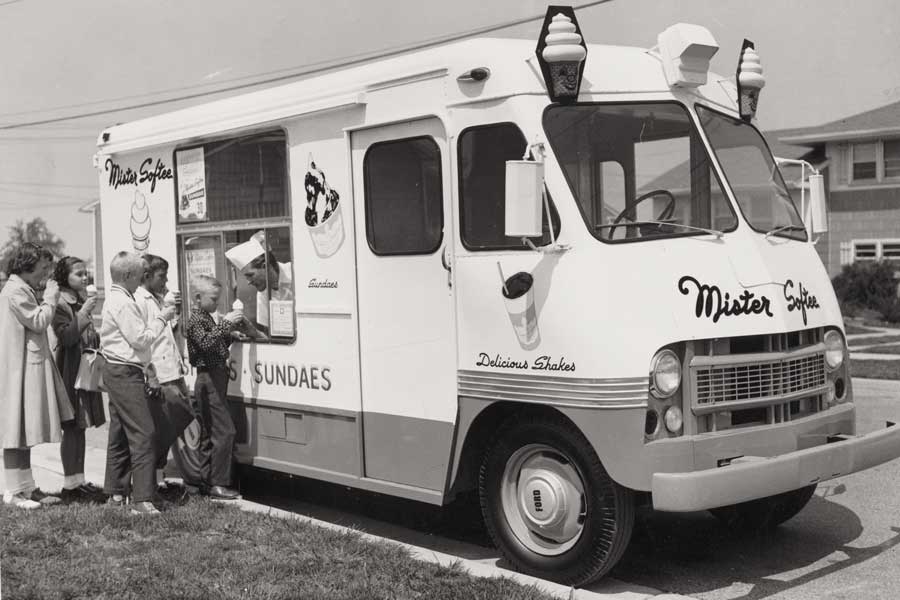
An archival photo of an early Mister Softee truck.
And I’m going to get to ride shotgun, envied by all as I jingle, jingle through town promising simple pleasure at a modest price. If only for a day, I’m going to learn what it’s like to be surrounded by such happiness. Right now, I can think of no better job.
S-O-F-T Dubble-E
Mister Softee!
Morad beckons me onto the truck. The kids give me side-eye and wonder wassup. From the outside, the truck looks like it hasn’t changed for decades. All the exterior decals, from Mister Softee’s iconic mascot, Conehead, to the pictorial menu, are straight out of the 1960s. But don’t be fooled. On the inside, a Mister Softee mobile is like a tricked-out UPS truck, with a Freightliner engine, a high-powered Electro Freeze soft-serve machine, and equipment custom-designed at headquarters. The truck costs more than some Philadelphia rowhomes.
Which is astounding when you consider that Mister Softee was born in a garage in West Philly in 1954 — about 10 miles from where Morad and I are trawling for customers — and has grown from a novelty into an icon.
Every decade has served Mister Softee survival challenges. The first for Michael and John P. “JP” Conway, the third generation of family leadership who took the helm in January of 2020, was COVID. Many trucks lost most or all of last year’s prime ice-cream season. But the company seems to have resilience swirled into its DNA.
This year, the trucks are roaring back, delivering not just cones but, perhaps, the promise of a time when there was less vitriol. Ice cream is a happy business. Maybe it’s the one thing that almost everyone in this hyper-partisan, increasingly pugilistic world can agree on. And maybe it’s exactly what we all need this summer.
It’s been rough times out there, and there’s a lot of healing to be done. Is Mister Softee up to the task?
Mister Softee has been a thriving business since it launched, more or less, at the 1956 Philadelphia St. Patrick’s Day parade. Two Irish-American brothers, James and William Conway, who had been experimenting with soft-serve trucks and business models for a couple of years, drove a Chevrolet panel truck they’d emblazoned with the name “Mister Softee” and tricked out with a generator and the country’s best soft-serve ice-cream machine. They roamed South Philly, smiling — always smiling — and handing out free dyed-green vanilla ice cream. Both men were married with children, and both had quit their jobs to pursue this particular vehicular venture. Their proof of concept needed to work.
In 1961, five years after that fateful run, as Mister Softee trucks spread out across the country, St. Louis Post-Dispatch columnist Jack Rice called the brothers geniuses: “They put the ice-cream parlor on wheels … now they are living off the butterfat of the land.” Today, March 17th is celebrated as an anniversary at Mister Softee’s South Jersey headquarters. But the Conways’ success story began, as many entrepreneurial tales do, with an idea spurned.
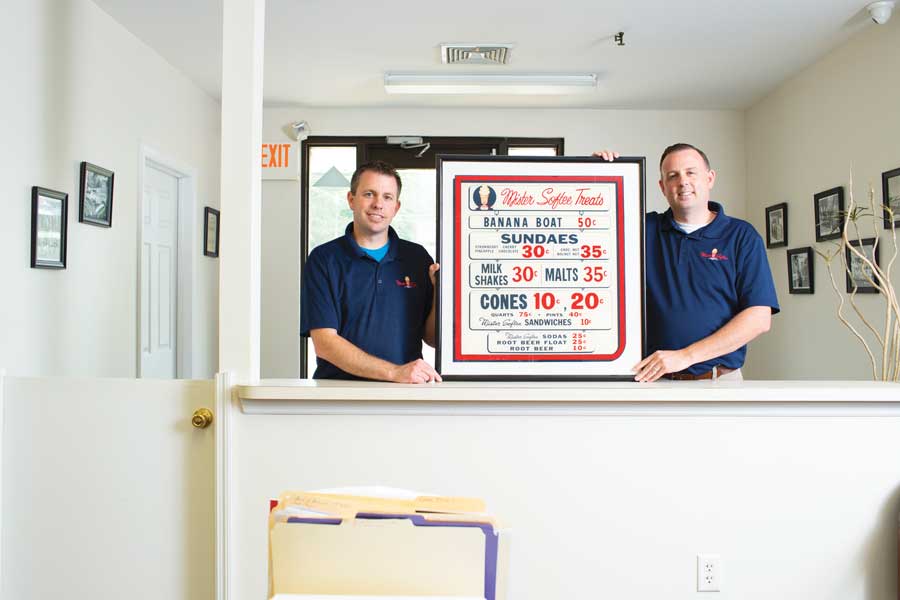
Brothers Michael (left) and John P. “JP” Conway, Mister Softee’s third generation of Conway family ownership, pose with a circa-1960s menu. Photograph by Scott Lewis
The Conway brothers’ mother, Mary, died in 1938, leaving four sons, including James, 11, and William, 16. Their father, William, had emigrated from County Mayo, one of the areas of Ireland hit hardest by the potato famine. He was a driver for a Philadelphia trolley company and encouraged his sons to go to college. As the legend goes, William, a 1943 St. Joe’s accounting grad, college basketball player, and World War II Navy vet, was standing in line one day to buy ice cream and wondered why the stuff couldn’t be delivered. Younger brother James, a Korean War vet and a 1949 Wharton business grad and four-year football letterman under legendary Penn coach George Munger, agreed.
The idea wasn’t that far-fetched. This was the era of the bread man, the egg man, the milkman. Before supermarkets offered cheaper products and suburban sprawl made delivery routes too long to be profitable, men brought basic staples to your front door. It just so happened that William and James both worked at the West Philadelphia outpost of Seattle-based Sweden Freezer Manufacturing Company, founded by autodidact Harvey F. Swenson — an inveterate inventor who, out of his love of ice cream, created a milkshake machine in 1932 and went on to engineer the best soft-serve ice-cream machinery in the country.
The Conways began to notice that Sweden Freezer customers were buying ice-cream machines to install in trucks, then driving around and looking for customers. But taking soft-serve ice-cream machines off the counter and onto the road is easier said than done. Popsicles and ice-cream sandwiches were easy — stick them in a freezer and drive. That was what Youngstown, Ohio’s Good Humor and Philly’s Jack & Jill had been doing since the Great Depression.
But soft-serve machines were delicate, requiring shock absorbers to mitigate the bump and grind of the road. Constant use and high volume meant the machines were also given to overheating. The Conway brothers paid attention when customers returned with their beat-up machines for repairs, and they tried to get Sweden Freezer to understand the opportunity in the nascent mobile soft-serve ice-cream business.
Sweden Freezer executives weren’t interested, so in 1955, James and William up and quit Sweden Freezer to build a better ice-cream truck and, in doing so, chase a better life.
On his truck, Morad explains the Conway brothers’ blueprint for selling ice cream to me: a clean truck. Check. A good product. Check. The best equipment. Check. Oh, and maybe the most important piece: a smile. To sell ice cream, we’ve got to put our personal problems aside, Morad tells me. We smile for hours. Check.
A Mister Softee franchise — they cost between $170,000 and $200,000 as of 2019 — has to hustle in something like $120,000 in sales per season to clear about $55,000, although nobody likes to talk exact figures. Michael Conway says the rest of the money goes to expenses like supplies, royalty fees, fuel, utilities, parking, insurance and taxes. If we’re just talking cones, Morad would have to sell one every three minutes of every day throughout the seven-month season to clear that hurdle. For some vendors, one truck isn’t enough to make a good living. Even after accounting for hiring drivers, more trucks mean more profit. Morad, who owns seven Mister Softee trucks, captures enough of the $9 billion U.S. ice-cream market every year to make a good living, keep his wife happy, and salt away some savings to send his twins and oldest daughter to college.
“I sell,” he says, “a lot, a lot, a lot of cones.”
The first thing I learn as we take off down Wadsworth Avenue is that what makes the ice-cream business lucrative is also what makes it hazardous: kids. Kids are everywhere, and they come at you from anywhere. Even a quiet block can erupt into a cacophony of scrambling, pleading children as the Mister Softee jingle draws near.
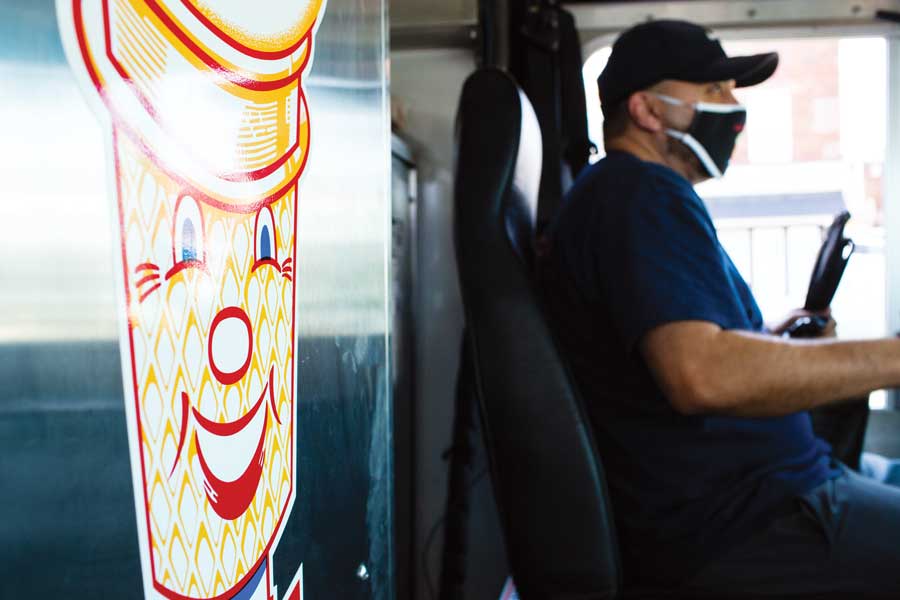
Khalil begins his eight-hour shift in the West Oak Lane and Elkins Park neighborhoods. Photograph by Scott Lewis

Damar Alexander, five, bites into a vanilla cone. Photograph by Scott Lewis
Morad always stresses to new drivers the need to pay attention. I’m an anxious passenger by nature, and for hours, my head is on a swivel: right, left; right, left; right, left. Kids. Everywhere. Despite the stop sign that pops out of the truck’s side like the one on a school bus, cars may or may not stop. Laughing boys on bicycles play chicken with the lumbering blue truck. Drivers in hero mode whip in front of Morad, brake short, jump out into traffic, and swagger over to buy their kids a cone. People are always waving you down. Kids come at you from anywhere.
And because of those kids, we sell a lot, a lot, a lot of cones.
When they first went out on their own in 1955, the Conways called their new business Dairy Van. What separated their trucks from others was that they invested in high-quality equipment and paid close attention to the engineering details. William had put up his savings, and James drove around West Philly for 16 hours a day, selling 10-cent cones. Business was okay, but short of where they wanted to be. From the start, William and James wanted to build a multimillion-dollar firm. Before they could do that, they needed to get out of debt.
“Every new business needs a rich uncle at the start,” William told the St. Louis Post-Dispatch in 1961. “Makes it more convenient. We didn’t have a rich uncle, but we had our cousin — Patty Cavanaugh.” Patrick Cavanaugh was the well-heeled restaurateur behind Cavanaugh’s Railroad Tavern and Restaurant (better known today as Cavanaugh’s), near 30th Street Station. He lent the brothers some $70,000 to launch Dairy Van. That’s equal to nearly $700,000 today. Cousin Patty was generous, but he wanted to be repaid.
By the end of 1955, the Conways already had six trucks. Good, but not good enough.
So they made the decision to get out of the soft-serve-selling business and get into the soft-serve-truck-selling business: They would become manufacturers and sell no-name trucks to would-be entrepreneurs. In 1956, they sold 43 trucks. In 1957, they sold 132. But the new vans and the new sellers were both too green: The vans had engineering issues, and the custard-slingers had so many questions. The brothers saw a bigger opportunity. They would sell their expertise — everything they’d learned about selling cones on those long days driving around West Philadelphia — along with the trucks. That’s how James and William Conway would pay Patty back. (They’d also eventually have to pay a man named Albert Zampetti, an early partner in the company that would become Mister Softee. He took Cavanaugh and Conway to court, claiming he was elbowed out of the business. In 1962, the Pennsylvania Supreme Court ruled that Zampetti was “entitled to share in the ownership, profits and bonuses” of the company. Zampetti then largely vanishes from the public record.)
James Conway Jr., the son of James and one of the company’s second generation of Conway co-owners — he served as vice president of the company from 1998 to 2020 — recalled his father and uncle once saying, “If we’re going to do all this hand-holding, we should create the business as a franchise. That way, we can get royalties and make our money back. We’ll sell the supplies, trucks, and everything that goes with it.”
In the 1950s, franchising wasn’t exactly new. Hertz began the practice in 1925, and companies like Kentucky Fried Chicken, Avis and Carvel followed suit. But the timing was right: For immigrants and American servicemen back from the war with their separation pay — GI Bill money — a franchise was attractive and affordable. It gave them the chance to own their own business but with much less risk than starting from scratch. Franchising grew 3,600 percent between 1955 and 1970.
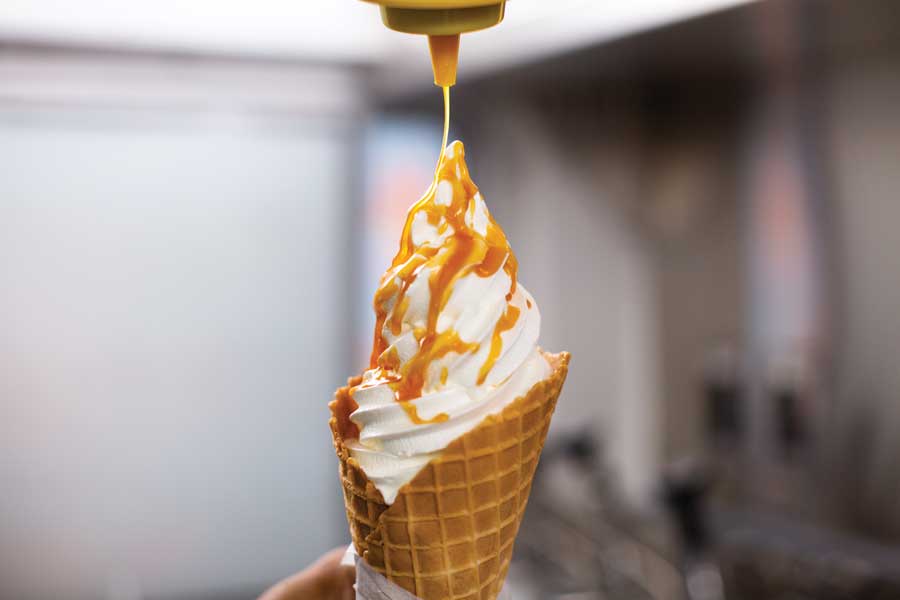
Morad artfully tops a vanilla waffle cone with caramel. Photograph by Scott Lewis
After a brief run as “Dari King,” which they admitted was too similar to Dairy Queen, the brothers tapped a neighbor who worked in advertising. Together, they came up with a new name — Mister Softee, Inc. — and a mascot, Conehead.
The Conways ran ads in papers across the country promising that for a $4,000 cash investment, franchisees would earn $8,000 to $11,000 during the ice-cream-selling season. In a 1956 ad in the Sunday Inquirer, the Conways promised, “You don’t need experience to operate your own fully equipped ‘dairy-on-wheels’ with all the profits of a permanent stand without all the limitations and headaches.”
Demand skyrocketed, and the company started growing rapidly. By the end of 1960, they had 1,609 trucks, and co-founder James Conway told the St. Louis Post-Dispatch that by the end of 1961, they “expected to have 2,350 trucks in 37 states and Puerto Rico and England.”
“Because they were financing the sales, controlling inventory, and receiving royalties, they had three streams of revenue,” Conway Jr. recalled. Mister Softee grew richer and richer.
Each of Morad’s trucks is considered a separate franchise operation with its own territory. One of his territories covers West Oak Lane and parts of Cheltenham. Another truck roams Olney. A third operates in Port Richmond and Bridesburg; a fourth works in Central Jersey; a fifth is based in Hazelton and two more crawl the Poconos.
A Mister Softee truck should never see a competing Mister Softee franchisee in his area. This guarantee of exclusivity is what makes the financials of being an ice-cream vendor work. Otherwise, it would devolve into chaos, with drivers underselling each other and racing to be first at prime locations like school dismissals or company break times.
A soft-serve knockoff would likely have a hard time finding footing in Mister Softee territory, Morad says, because of the company’s reputation for service and quality. I don’t say anything, but I don’t agree. After all, on a hot day, the best ice-cream truck is the closest ice-cream truck. I think a knockoff truck wouldn’t make it in Mister Softee territory because of the company’s reputation for zealously defending its interests. Jeff Zucker, the firm’s longtime Philadelphia lawyer, once told South Jersey’s Courier-Post that Mister Softee goes to court regularly to protect its trademarks — an expensive undertaking: “It’s important for Mister Softee to make sure people aren’t free-riding or poaching.”
When you visit a Mister Softee truck, you don’t just buy a cone; you enter yesteryear. Yelp reviews of Mister Softee are often more about people’s remembrances than ratings of the ice cream:
Mr. Softee is pretty much everyone’s childhood anthem. … I don’t need to convince you guys, let’s all revert back to our 10-year-old selves as we savor our soft-serve ice cream :)
The key to nostalgia is consistency. Every truck since the company started has had the same silly mascot, the same decals, and essentially the same ice cream. Since 1960, they’ve all used the same jingle — which the Conways paid Philly advertising legend Les Waas to write for a radio ad — burrowing it into bystanders’ ears.
Research shows that we’re not only more likely to spend when we feel nostalgic, but that nostalgia binds us to a brand — so we’ll spend over and over again. People come to the truck and start to ruminate on the good old days, and the next thing you know, they’ve bought a round of ice cream for everyone.
When you visit a Mister Softee truck, you don’t just buy a cone; you enter yesteryear.
That happened on the 7100 block of Louise Street. It was close to 7 p.m. A man emerged from a house wearing a pink hoodie with a pink skull on the front. He told Morad he grew up in Philly but was visiting from Atlanta, and he started to complain: “We don’t have no Mister Softee down there.” Then he called out for his nieces and nephews, and children of various heights poured out of the house. Morad spent the next few minutes feverishly filling orders while Uncle Pink Hoodie reminisced. And then Uncle Pink Hoodie paid for everyone.
Morad is only 42, but he’s been serving up soft-serve for about 30 years. That wasn’t his plan. After graduating from Olney High, he attended the Community College of Philadelphia. He knew he was going to do something entrepreneurial, but he wasn’t sure what. His father owned several Mister Softee franchises. Morad had begun helping out as a kid, but he intended to do something different.
One day led to another. The money he earned working for his dad wasn’t bad. He got married, and the next thing he knew, Morad had inherited his Palestinian father’s American Dream — and his Mister Softee franchises.
Like James and William Conway, immigrants have been drawn to the Mister Softee business from the start. The first wave of franchisees were Irish, Italian and Greek. Then came owners of Caribbean descent. In the 1990s, Latin American buyers, especially from Puerto Rico, became interested. Today, in Philadelphia, it’s families from the Middle East.
Morad’s father, Khalil Yousif, emigrated from the upheaval in Palestine in the 1970s. The U.S. had enacted the 1965 Immigration Act and opened its doors to those from regions other than Europe. “He came to America looking for a new life in the land of the free. … ” Morad’s voice trails off as we drive in circles.
It takes a while, but I learn to scan the block as we lumber down the street at 10 m.p.h. in search of opportunity — folks with desire in their eyes and dollar bills in their hands. “Dad wanted to start his own business, and Mister Softee was affordable,” Morad explains between cones.
Morad says his father purchased his truck in the late ’80s, a decade or so after hearing about the opportunity from a friend. He was part of a wave of owners who helped revitalize Mister Softee in the city after a contraction following the company’s peak in the ’60s and ’70s.
During ice-cream season, from April through October, Morad, like his dad before him, works 10-to-12-hour days. The pace is unceasing, and he’ll barely see his family. Summer vacations are out of the question. But the work, if you have multiple trucks, provides a decent living.
When I ask Morad about his children taking over the business, he talks of them graduating from college instead. “I work Mister Softee so they won’t have to,” he says quietly.
After a few hours on a Mister Softee truck, you learn that another trick to selling is perpetual, if halting, motion: Our day is Go slow, stop, sell fast; go slow, stop, sell fast; go slow, stop, sell fast. That rhythm screeches to a halt whenever a customer ponders a choice. Mister Softee only carries two flavors — vanilla and chocolate — and 60 to 80 percent of sales are vanilla ice-cream cones. That means that no matter how long customers take to decide, most of them are going to buy a $2.50 vanilla cone, most likely with rainbow sprinkles.
Morad says the secret to success is “patience, patience, patience.” A good ice-cream vendor will never make a customer feel rushed. But dawdling customers eat into Morad’s profits, keeping him from making other potential sales.
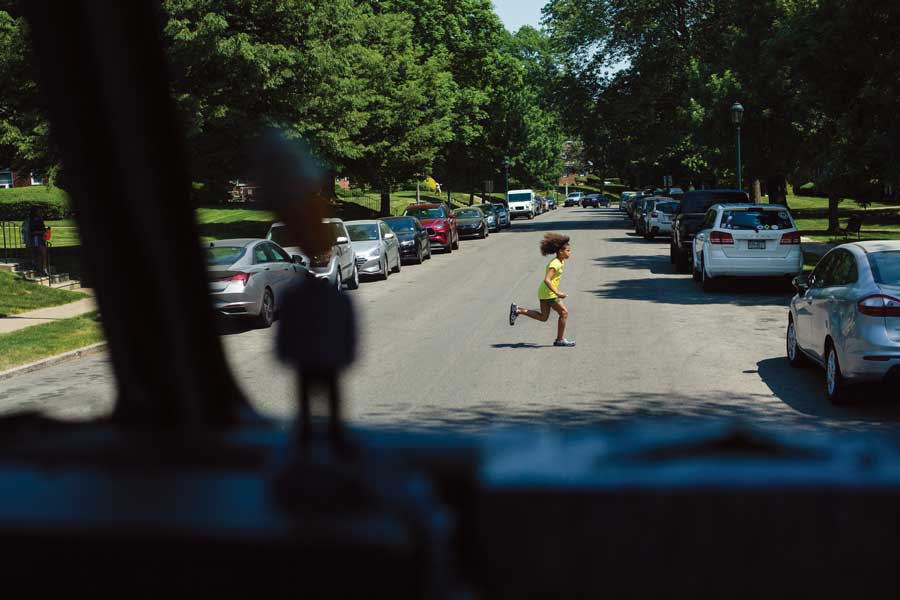
A potential customer darts across the street. Photograph by Scott Lewis
For example, after we visit the Lynnewood Gardens section of Elkins Park, he doesn’t get to 7300 Rugby Street in West Oak Lane until 7:51 p.m. “Time is against us now,” he says. “If I had gotten here at 6:30, we would have gotten the after-dinner sales.” After dinner is a literal sweet spot when parents are primed to say yes to dessert. Come too late, and kids are getting ready for bed. An hour is the difference between boom and bust.
Mister Softee only carries two flavors — vanilla and chocolate — and 60 to 80 percent of sales are vanilla ice-cream cones.
Throughout the day, Morad controls what he can — lightning-fast service, no food or pee breaks, polite but not overly diffuse chatter with customers — and accepts what he can’t: moody weather, fleeting time, double-parked cars.
By the time we reach Rugby Street, I’m getting weary. The truck’s jump seat is hard and uncomfortable. It’s mostly dark, but we find a few folks still hanging out on their porches. Children grab for monied adults, and they all saunter over. Some examine the menu as if deciphering an ancient philosophical text — as if it’s their first time ordering ice cream. Hungry, tired and cranky, my butt aching, I want to scream: “For God’s sake, you want a vanilla cone with rainbow sprinkles!”
There’s always been a disconnect between vanilla as an adjective — ordinary, boring — and vanilla as a noun — a complex, fragrant spice, the most popular ice-cream flavor in America for the past 200 years. Mister Softee may be the missing link.
Between Mister Softee’s founding brothers, there are 23 grandchildren. Two of them recently became the third generation of family management. Michael and JP Conway approach running Mister Softee the way their father, John P. Conway, did. And John Sr. ran Mister Softee as his father, William Conway, did. That means a dedication to vanilla in both of its meanings — to being Switzerland in a world full of combatants. In its 65 years, Mister Softee has taken no public positions on the civil rights movement, the war in Vietnam, nuclear disarmament or climate change. There are no messages on its website about diversity or George Floyd. It doesn’t swing right or left. It isn’t a member of the local Chamber of Commerce. It expresses no opinions about the Eagles, the Sixers, the Phillies or the Flyers. Mister Softee is on Facebook, where its posts are purely promotional, and on Twitter, where it’s uttered nary a tweet since 2014.
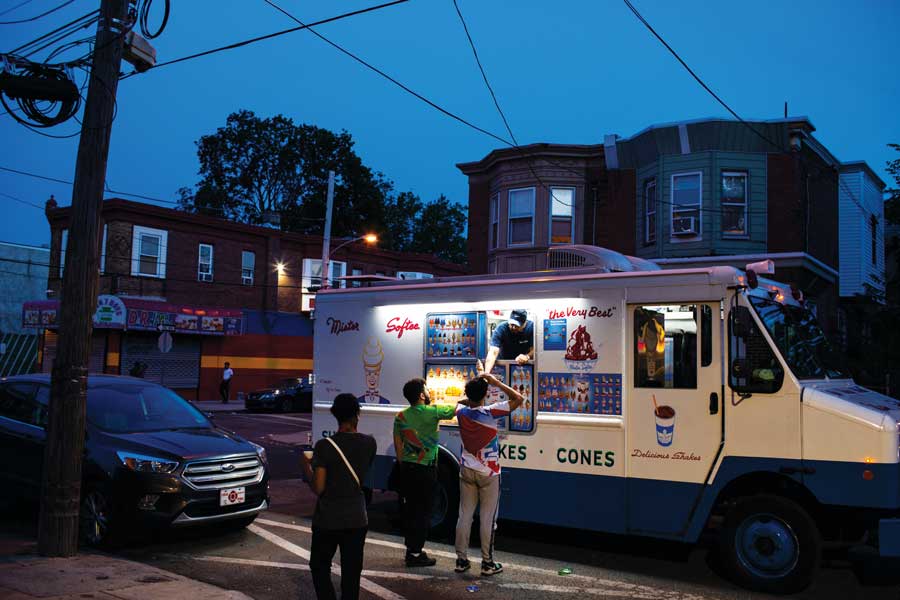
Franchisee Morad Khalil serves an order toward the end of his day. Photograph by Scott Lewis
Michael, the company vice president, and I are sitting in the Mister Softee conference room at Runnemede HQ, surrounded by posters of franchisee conventions from the ’60s and ’70s. It appears that nothing has changed for decades — as if William and James Conway could walk back in any minute and start running the business again.
Like Morad, Mike is a young man with a long Mister Softee history. He started working for the company as a 15-year-old, cleaning and stocking trucks, as his father did before him. He’s 39 now, but he bought his first Mister Softee truck 20 years ago, and juggled college and ice-cream runs along a route in West Deptford. After he graduated from St. Joe’s with a degree in business management, he went to work for the company full-time, running his own franchise. He’s never worked anywhere else.
Steeped in family business culture, Michael knows how to politely steer conversation away from anything remotely controversial. Talk of politics, religion, money — verboten. Company scandals? Business missteps? No, thank you. His family, becoming a first-time dad, personal interests — off-limits. All I get out of him is that he’s married to a former Mister Softee vendor and that his wife, Harbor Conway, first drove a South Jersey route for her stepfather and has been described as able to sell ice cream to the devil.
When I ask directly about politics — “Wouldn’t a Mister Softee truck be as welcome at a Proud Boys event as a Black Lives Matter event, because everyone likes ice cream?” — Mike doesn’t take the bait.
There’s a business saying: “Shirtsleeves to shirtsleeves in three generations.” It means that most family businesses fail by the time the grandchildren are running things, if they even make it that far. The Conway brothers are trying to be the exception. A few months after Michael and JP took over, nonessential businesses were told to shut down due to COVID. Heavy is the head that wears the Conehead.
So I toss Mike a straightforward question about COVID-19.
“Last year, we changed our protocols, but we did okay because people were home,” he says, swiftly dispensing with the company’s biggest challenge in decades.
But not the only challenge — Mister Softee is no stranger to bitter conflict, despite the sweet facade.
In 2013, a New York franchisee named Dimitrios Tsirokos, armed with his fleet of a dozen Mister Softee trucks, staged a coup. Dissatisfied with franchise fees and the cost of approved Mister Softee product, Tsirokos changed the name of his trucks to Master Softee, a flagrant violation of his franchise agreement. The Conways and Jeff Zucker took him to federal court and eventually won, but the damage had been done. Tsirokos rebranded as New York Ice Cream, rallied other rogue drivers to his fleet, and took over valuable territory in midtown Manhattan. As one renegade driver told the New York Times, the tourist-dense area “from 34th to 60th Street, river to river, that’s ours. You will never see a Mister Softee truck in midtown. If you do, there will be problems, and you won’t see them there very long.” It was reminiscent of the turf wars the company experienced in its nascent years as it expanded into cities like Chicago.
More recently, several Mister Softee drivers in New York ignored advice from Runnemede and started selling ice cream at the height of the pandemic lockdowns. Michael told ABC News at the time, “We can say ‘Don’t go out,’ but we don’t have the keys to every single truck.”
Then, a few weeks before Philadelphia’s DA primary, the Fraternal Order of Police arrived at District Attorney Larry Krasner’s front door with a Mister Softee truck, dishing out free cones. FOP president John McNesby had a point to make — Krasner was soft on crime — and was using Mister Softee to send that message. Ben Cohen of Vermont’s Ben and Jerry’s, a Krasner supporter, got into the fray, calling Mister Softee “fake ice cream.”
When the Inquirer called Mister Softee looking for a comment, James Conway Jr., who remains with the company as a vice president, told the writer, “We’re really not interested in politics.”
Yet on the corporate Facebook account, the company posted a link to the controversy: “We are not taking a position on the issue BUT who doesn’t like FREE ice cream?”
Over the hours I spend with Morad, I see so many adorably cute children. One stands out. She can’t be more than three, with a bedazzled white headband. But that isn’t what grabs my attention; it’s the confidence she exudes.
When Morad arrives, even the surliest child enters a puppy-like state of happiness, smiling, jumpy and excited all at once. If kids can’t quite tell him what they want, he asks them to point to it on the menu. “I got you,” he coos gently.
Ms. Bedazzled stands quiet and poised. She knows what she wants.
For the first time today, though, it seems Morad isn’t stopping. He keeps driving slowly down the street. Finally, he brakes and goes to the back of the truck, and for the umpteenth time, he slides the service window open.

Noa Rampasard, two, shows off her vanilla cone topped with Fruity Pebbles cereal. Photograph by Scott Lewis
“What did your mother say?” he asks, with a tinge of concern. It’s a voice I haven’t heard before, mouthing a question I haven’t heard before.
But Ms. Bedazzled has money, and commerce commences. Then she turns, and I catch a glimpse of her chocolate and vanilla swirl on a cone. No sprinkles.
When he finishes, Morad climbs back into the driver’s seat. Before pulling out, he explains my final lesson: In a world of delivery apps and impersonal commerce, there’s no substitute for knowing your customers.
“If her mother had been home, she never would have been allowed to have ice cream.” He’s been down this road before. But today, on the stoop, sits an indulgent grandmom, watching. The little girl’s delight is her delight, too. That cone, full of memories, is as much for her as for her granddaughter.
It’s in that instant that I see the future. This small ritual, with so much joy embedded — hers, her grandmother’s — is powerful. It’s the cornerstone upon which the Mister Softee empire is built, and what creates the next generation of Mister Softee lovers, one cone at a time.
Published as “Riding Shotgun With the King of Summer” in the July 2021 issue of Philadelphia magazine.

Philadelphia magazine is one of more than 20 news organizations producing Broke in Philly, a collaborative reporting project on solutions to poverty and economic mobility in the city. Read all our reporting here.


